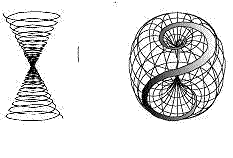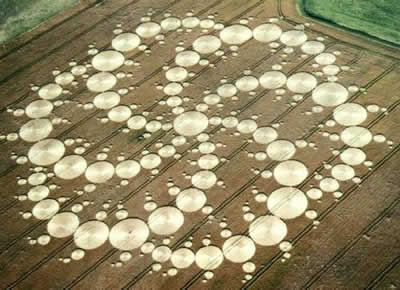Wow, I found a very interesting text, from a person named Jan Wicherink, who wrote a book bringing together information by many researchers, including Nicolai Tesla, Daniel Winter, David Wilcock and Nassim Haramein. It gets interesting from
chapter 3 onward, and in chapter 6 of the book I found an explanation of Dan Winter's basic theory, in a very organized way! Hurray!!
Excerpt from
Chapter 6:
Implosion physics
Daniel Winter presents a physics that is called ‘implosion physics’. He concludes that the entire universe, the material world is created from one non-material substance, the aether. The aether is a kind of super conductive fluid that flows right through all physical objects. The aether vacuum is an extremely dense nonetheless frictionless medium. The best comparison for the aether being non-material in nature is the super-conductive state of helium. When helium is cooled down to temperatures below 2 degrees Kelvin it becomes a super-fluid, which means that objects can move through this fluid with no friction at all.
Daniel Winter now believes that vortexes, little eddies or tornados in the fluid-like aether are the basic building blocks of matter. Since the aether is some kind of a fluid, it follows the well-known physical laws of hydrodynamics.
According to Daniel Winter the aether creates vortexes, little tornados of whirling and spiralling energy in the ocean of aether, our universe. The vortexes in the aether are like the little eddies in a river. The vortex is nature’s natural flow form for fluids. The same vortex flow form is created every time we pull the plug in our bathtub!
When two of these aether vortexes join their funnels they form a torus:
Single aether vortex
Double vortex = Torus
Now the torus is a unique flow form in hydrodynamics, it allows fluids to spiral inwards and outwards on the same surface of the torus. It is a very stable flow form.
If the universe is essentially created from one universal substance, the aether, it must be form that is used to create different and separate things out of this universal substance. The torus is nature’s perfect flow form to create a seemingly separate entity in the formless aether that is stable enough to last.
The torus flow form is similar to the rings created by the smoke of a cigar. The cigar smoke whirls inwards on top of the smoke ring and comes out again on the bottom of the ring. It is constantly folding inwards to come around on the other side flowing outwards. The torus is often compared with the shape of a doughnut or an apple. It’s a spherical form folded inwards at the poles to form a small hole in the middle.
The individual aether torus doughnuts can be nested inside each other. Nesting torus doughnuts requires that the vortex cones of the torus are aligned with the faces of the Platonic solids.
The flat bottom of a vortex cone should touch the face of a Platonic solid.
As an example we show the cube that contains 3 vortex pairs or 3 torus doughnuts aligned perpendicular to each other in a cube and 5 nested torus doughnuts in a dodecahedron.
Now we may remember from the Cube of Metatron that the Platonic solids themselves can be nested, they fit into each other. Let’s take the cube, when lines are drawn to interconnect all centres on the 6 faces of the cube, they form the octahedron. The octahedron is fully circumscribed by the initial cube. The same process can be repeated now with the octahedron by interconnecting the centres of the faces of the octahedron. The result is a cube now circumscribed by the octahedron. This process can go on and on forever, creating smaller and smaller Platonic solids perfectly nested into each other, it creates a fractal, a repetitive geometric pattern.
Nested Platonic Solids
The nesting of the Platonic solids is not restricted to the cube and octahedron. All Platonic solids can be nested into each other. It is the nesting of the Platonic solids that creates the electron shells of the atom. Similarly however at a much smaller scale the nucleus of the atom is formed.
The electrons in the electron shells correspond with the vortexes that are nested in Platonic symmetries. According to Daniel Winter, physics has mistaken these vortex waveforms for electron particles. Within the atom, the electrons orbit the nucleus at a fixed distance from the nucleus. The sphere that describes the orbital plane of the electron is called the electron shell. There are different types of shells in the make up of the atom that were given the names s,p,d and f shells and they contain respectively 2, 6, 10 and 14 electrons maximum.
Each vortex pair in the doughnut corresponds with 2 electrons and when the doughnuts are organized inside a Platonic Solid we get the equivalent of an electron shell. Here’s the correspondence:
1 vortex pair (1 torus) corresponds with the 2 electrons of the s shell.
3 nested vortex pairs in a cube correspond with the 6 electrons of the p shell.
5 nested vortex pairs in a dodecahedron correspond with the 10 electrons
of the d shell
7 nested vortex pairs in an icosahedron correspond with the 14 electrons
of the f shell.
So matter is the stable flow form pattern emerging from the aether. It takes on geometrical shapes from a formless energy, creating the illusion of separate electron particles in the electron shells and the particles that make up the nucleus.
Mainstream physics has never been able to explain why the atom has these ‘random’ numbers of 2, 6, 10 and 14 electrons in its electron clouds, the orbital shells around the nucleus. Daniel Winter’s model of the atom now explains exactly why these number show up in the period table of the elements! These numbers are related to the geometrical properties of the Platonic Solids! Also for the very first time we have an explanation as to why the electron does not crash into the nucleus and how its radiated energy is replenished. Electrons are not particles that encircle the nucleus, instead they are standing wave patterns at discrete distances from the nucleus! The aether simply replenishes these standing waves eternally.
Another way of looking at the torus shape is regarding it as a form that can be perfectly described by a set of Phi spirals.
Phi spirals in nested doughnuts
Each Phi spiral is actually a series of pure sine waves. It is a well-known principle in physics that any complex wave shape can be created from the sum of simpler pure sine waves with different frequencies and amplitudes. This principle is called the Fourier principle. The Phi spiral is constructed from a series of harmonics with wavelengths that comply with the Golden Mean version of the Fibonacci sequence:
When pure sine waves with wavelengths of 1/ ?, 1, ?, ? ², ? ³ etc. are added together, they will form a perfect Phi spiral.
see image
When these Phi spirals circle around the torus they meet and interfere. As a result of this interference two new additional waves will be created. What is important to notice is that both new waves will have wavelengths that are again in the Fibonacci series. This allows that the interference will be non-destructive since the interference will simply result in more harmonics in the Fibonacci series.
Whilst destructive interference is the norm in wave interference, the only exception in nature is when the waves interfere with Golden Mean ratio wavelengths! In other words, the Phi spiral can re-enter itself around the torus shape without destroying itself. So the Phi spiral is the universe’s only possible way to nest and become self-organizing. This is how stable matter can be formed from electromagnetic energy as a form of pure wave interference.
Electromagnetic energy in a straight line is what we usually call light. When this same light chases its own tail around the surface of the torus shape we call it matter. In other words the atom is pure electromagnetic energy in a form that we no longer perceive as light but as matter, or to put it in Daniel Winter’s own words:
"So now we have this dualism that waves in a line are energy and waves in a circle are mass, and because we don’t know how the wave got into a circle from the line and out, we conceive mass as separate from energy. E=MC^2 simply said that yes loop the speed of light back around on itself, and you made mass of energy"
The Golden Mean spirals of the torus shape eventually spiral into a perfect zero still point in the nucleus of the vortex that coincides with the nucleus of the atom. So these sine waves implode inwards into increasing smaller wavelengths. The implosion of the Golden sine waves into smaller and smaller wavelengths not only increases the frequency of the waves but also increases the speed of the waves to become super-luminal waves (travelling faster than light). According to Daniel Winter, this is what gravity really is, the cascade of Golden Mean electromagnetic sine waves that gain an ever-increasing velocity breaking the speed barrier of light. Einstein had always assumed that electromagnetism and gravity were related and Daniel Winter explains us how this connection is established.

When doughnuts are nested to form the electron shells of the atom, the only requirement to continue this form of non-destructive interference is that these doughnuts align according to the Platonic Solid geometries.
When these nested doughnuts inside the atom are arranged according to the Platonic solids symmetries, all waves will rush into the center of the atom, creating repetitive, recursive or fractal patterns that not only shape the electron shells but also the nucleus. Eventually the fractal patterns disappear into a zero point in the nucleus of the atom. The implosion of the electromagnetic waves into shorter and shorter wavelengths is what gravity really is. In a way the torus is a miniature black hole that attracts the light into itself creating gravity.
Universal principle
The repetitive patterns of the Platonic solids that fit into each other are fractals. A fractal is a repetitive pattern that can be scaled to any size. The scale may change but the ratio is held constant.
Now the fractal patterns that shape the atom, according to Daniel Winter also shape our planets and stars, in fact the universe.
A fractal has self-similarity at all scales, it’s the same geometric pattern repeated. The inner structure in a fractal is reflected in the outer structure. Fractal means fraction of the all, indicating that each piece is part of the whole. It is the basic idea of a hologram and this is why according to Daniel Winter the universe at large is just a super-hologram. The fractals of electromagnetic energy interconnect everything with everything within the universe and are the basic building blocks of this hologram. The fractal repetitive structures of electromagnetic energy weave a giant cobweb throughout the universe.
The wavelengths of planets and stars are huge in comparison with the wavelengths of the atom, however when their wavelengths fit into the Fibonacci sequence of the Golden Mean, they interfere non-destructively; they implode and form a fractal attractor that we call gravity! This is how the planets and stars are connected by means of imploding electromagnetic waves that we experience as gravity.
So if the universe is in essence a hologram and there is only one principle that shapes everything from atoms to planets, stars, and the universe at large, we should find proof of these vortexes, Platonic Solids, and doughnut structures in all parts of the universe.
Continued
here.























